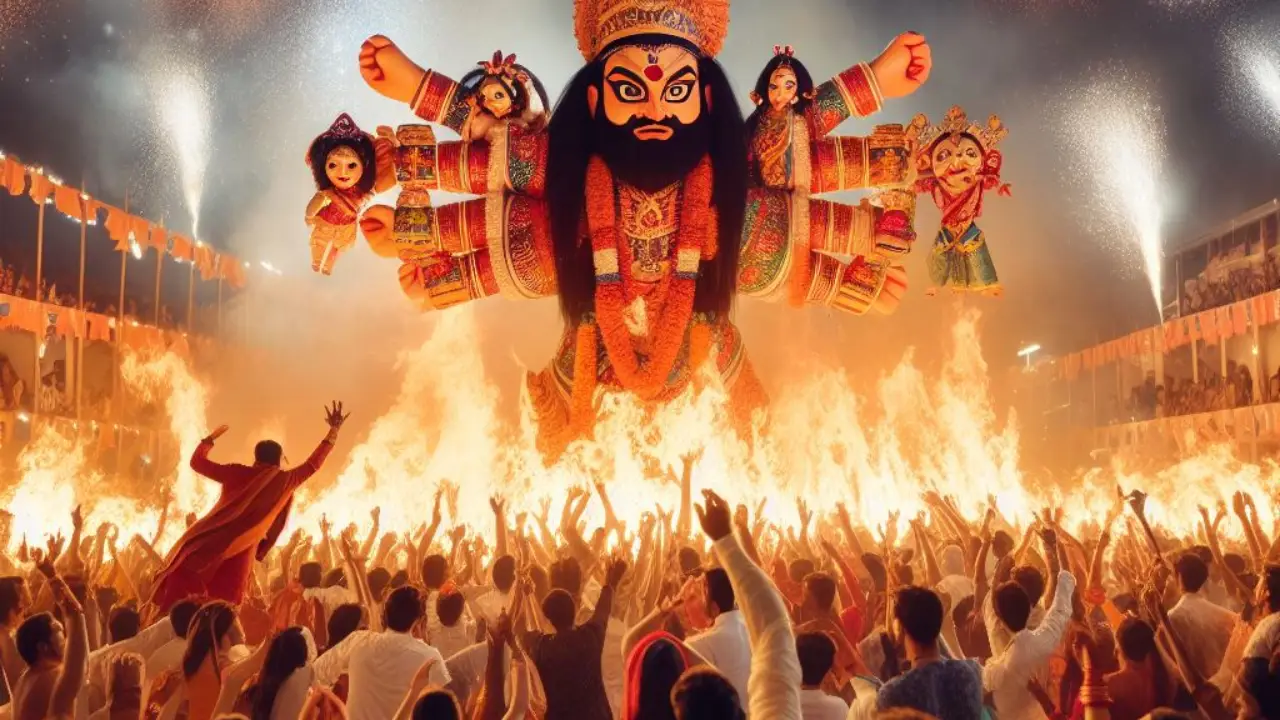Dussehra, also known as Vijayadashami, is one of the most significant and culturally diverse festivals in India. People celebrate it with immense enthusiasm and fervor throughout the country. This blog post will delve into the origins, rituals, and the profound significance of Dussehra.
The Origin of Dussehra
People celebrate Dussehra on the tenth day of Navratri, a nine-night festival dedicated to the goddess Durga. This grand festival falls in the Hindu calendar month of Ashwin (usually in September or October). It traces its origins back to the epic Indian mythology, the Ramayana.
Ramayana Connection
Dussehra primarily commemorates the victory of Lord Rama over the demon king Ravana. According to the Ramayana, Lord Rama, with the help of his devoted brother Lakshmana and the monkey-god Hanuman, defeated Ravana, who had kidnapped Rama’s wife, Sita. This triumph of good over evil signifies the essence of this day.
How Dussehra is Celebrated
People across India celebrate Dussehra with great pomp and show. They follow common traditions with unwavering dedication, although the celebrations vary from region to region.
Ram Leela: One of the most prominent customs is the performance of Ram Leela, a dramatic representation of the life and events of Lord Rama. People usually enact it during the nine days leading up to Dussehra, with the grand finale on the tenth day.
Effigy Burning: The highlight of the day is the burning of effigies of Ravana, his brother Kumbhakarna, and his son Meghnad. This symbolic act represents the destruction of evil forces. The effigies are filled with firecrackers, and when they burn, it’s a breathtaking spectacle.
Vijayadashami: On this day, people worship the goddess Durga and seek her blessings. It’s a day of victory (Vijayadashami), and people exchange gifts and sweets, signifying the triumph of good over evil.
Durga Puja: In Bengal, this day coincides with Durga Puja, a grand celebration that involves the worship of the goddess Durga. Lavish decorations, elaborate processions, and cultural performances are a part of this festival.
The Exchange of Apta Leaves: In the southern states of India, people exchange ‘apta’ leaves as a symbol of gold. This tradition is believed to bring prosperity and good fortune.
The Significance of Dussehra
Dussehra carries deep spiritual and cultural significance. It teaches us valuable life lessons and serves as a reminder of the eternal battle between good and evil.
Triumph of Good Over Evil: The central theme of Dussehra, the victory of Lord Rama over Ravana, symbolizes the ultimate triumph of good over evil. It encourages us to stand up against wrongdoing and uphold righteousness.
The Virtue of Truth: Lord Rama, the hero of this saga, exemplifies unwavering commitment to truth and morality. Dussehra reminds us of the importance of truth in our lives.
Festive Unity: Dussehra brings people from diverse cultures and backgrounds together in celebration. It is a time when the entire nation rejoices, regardless of differences.
The Contemporary Relevance
Dussehra holds contemporary significance as well, not confined to history and mythology.
Eradicating Evil Within: Dussehra encourages us to introspect and eradicate the evil within ourselves. It’s a reminder to conquer our inner demons.
Promoting Goodness: In a world often plagued by negativity and violence, this day inspires us to be good, do good, and be a beacon of light in the darkness.
A Grand Finale: Celebrating Dussehra Today
Dussehra is more than just a religious festival; it’s a celebration of the victory of righteousness. As the effigies of Ravana and his kin burst into flames, it’s a symbol of burning away the darkness in our lives. In today’s world, where chaos and evil often seem to hold sway, Dussehra becomes even more relevant.
This festival encourages us to strive for truth, goodness, and unity. It reminds us that good will always triumph over evil, no matter how daunting the odds may seem. As we celebrate Dussehra today, let’s also celebrate the values it represents.
Join the Celebration!
Dussehra, also known as Vijayadashami, is one of the most significant and culturally diverse festivals in India. People celebrate it with immense enthusiasm and fervor throughout the country. This blog post will delve into the origins, rituals, and the profound significance of Dussehra.
Dussehra is a time of joy, reflection, and unity. We invite you to share your thoughts on this magnificent festival and how it inspires you. Have you ever witnessed a Ram Leela performance or participated in the effigy burning? How do you practice the virtues of truth and goodness in your life? Let’s come together and celebrate the triumph of good over evil.
Leave your thoughts in the comments below and be a part of this meaningful discussion.

